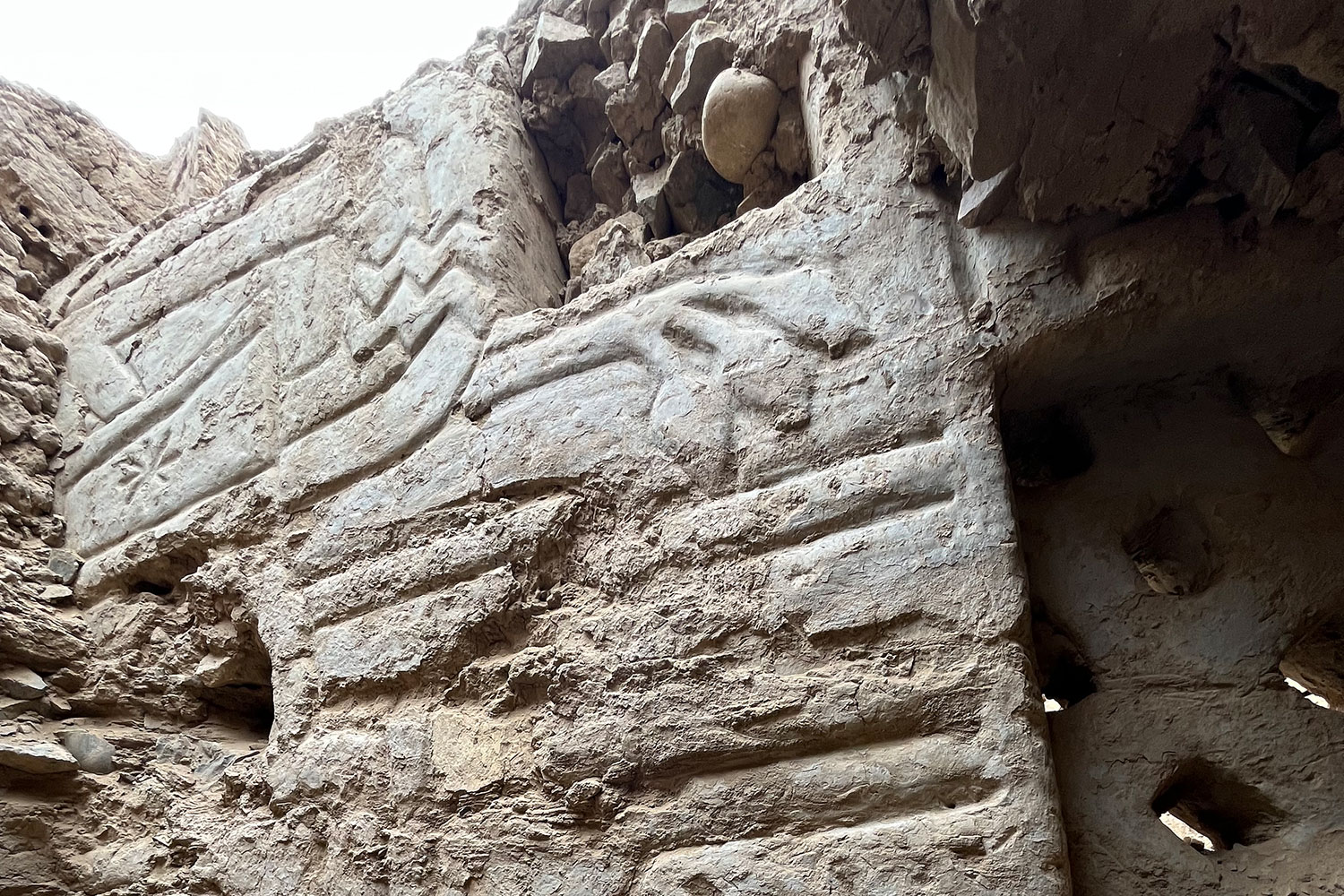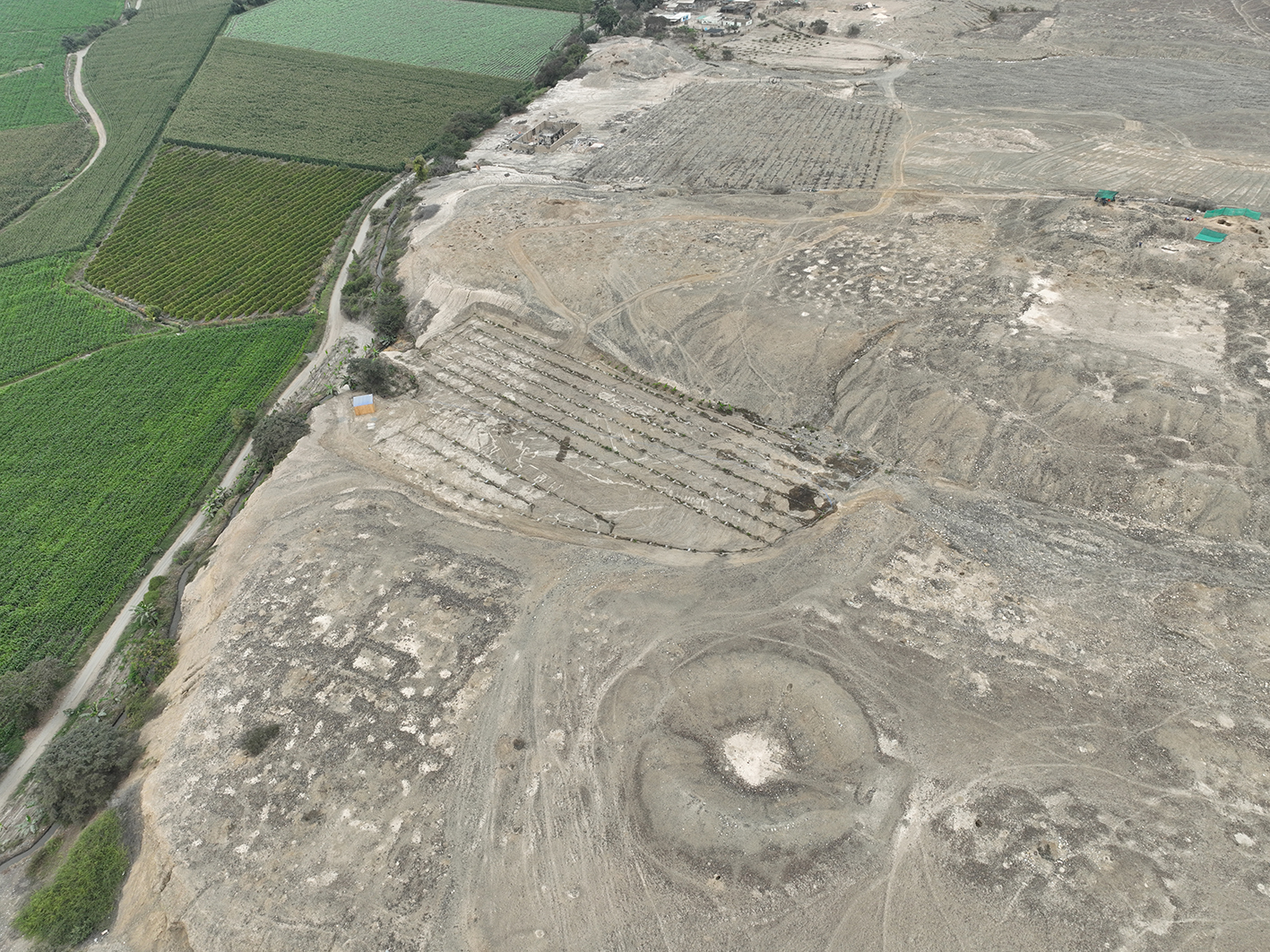Latin America
Related: About this forum'A truly unprecedented discovery': 3,000-year-old multicolored mural with fish, stars and gods discovered in Peru
By Kristina Killgrove
published August 28, 2025
A multicolored mural discovered in Peru is shedding light on pre-Inca coastal artistic traditions.

an archaeological dig revealing a large 3D mural with a backdrop of the Andes mountains
A view of the south face of the pre-Inca mural discovered at Huaca Yolanda in Peru. (Image credit: Pontificia Universidad Católica del Perú)
Archaeologists have uncovered a massive 3D mural on the northwest coast of Peru. Blue, yellow, red and black paints still adorn the 3,000-year-old mural, which is decorated with fish, stars and mythological beings.
"The imagery, decorative techniques and exceptional state of preservation make this a truly unprecedented discovery in the region," Cecilia Mauricio, an archaeologist at the Pontifical Catholic University of Peru who found the mural, told Live Science in an email.
Mauricio and her team began digging at the archaeological site of Huaca Yolanda in early July. During the first week of excavation, they uncovered the mural, which dates to the Formative Period (2000 to 1000 B.C.), so called because the first complex societies arose in what is now Peru at this time. The mural is nearly 20 feet (6 meters) long and 9.5 feet (2.9 m) tall.
The south face of the mural depicts a large bird with outstretched wings and a diamond motif on its head, Mauricio said, possibly representing an eagle or a falcon. On the north face, there are plants, stars and human-like figures that "seem to represent shamans," who were powerful people in that time period, Mauricio said.
"Current evidence suggests that the mural decorated interior spaces within the main atrium of a Formative Period temple," Mauricio said.
. . .

More:
https://www.livescience.com/archaeology/a-truly-unprecedented-discovery-3-000-year-old-multicolored-mural-with-fish-stars-and-gods-discovered-in-peru
malaise
(290,451 posts)Fascinating
Judi Lynn
(163,982 posts)The 3,000- to 4,000-year-old artwork decorated the wall of a temple atrium during Peru’s Formative Period
Sonja Anderson - Daily Correspondent
August 11, 2025

The mural is decorated with blue and yellow pigments. Pontifical Catholic University of Peru
Researchers in Peru have discovered a multicolored mural created by an Indigenous group more than 3,000 years ago. The artwork, which features astronomical and fishing-related motifs, is the first of its kind found on the country’s northern coast, says dig leader Ana Cecilia Mauricio, an archaeologist at the Pontifical Catholic University of Peru, in a statement.
The dig team found the mural last month, during an excavation of the Huaca Yolanda site, which is located in a valley in Peru’s northwestern coastal region of La Libertad. The three-dimensional mural once adorned the wall of an atrium in a ceremonial temple.
The mural reveals the rich symbolism of pre-Inca cultures in the region. It “has characteristics that are unique in Peruvian archaeology,” Mauricio tells Agence France-Presse (AFP). “We had never before found iconography or drawings of this type.”

Huaca Yolanda is an archaeological site in the Chao Valley, on Peru's northern coast. Pontifical Catholic University of Peru
More:
https://www.smithsonianmag.com/smart-news/this-colorful-mural-of-stars-and-fish-is-the-first-of-its-kind-found-on-the-coast-of-northern-peru-180987144/
Judi Lynn
(163,982 posts)
Updated 5 August, 2025 - 13:49 Gary Manners
Archaeologists working at the Huaca Yolanda archaeological site in Peru's La Libertad region have uncovered an unprecedented 3,000 to 4,000-year-old three-dimensional polychrome mural that is being hailed as a singular discovery in Peruvian archaeology. The remarkable find, measuring 4 meters long and 1.5 meters high, features intricate fish-like motifs with one displaying a body shaped like a 3D fishing net, alongside depictions of plants and stars painted in vibrant blues, yellows, and blacks. This extraordinary double-sided artwork was discovered within the inner wall of an atrium inside a U-shaped temple complex, offering unprecedented insights into the sophisticated artistic techniques and spiritual practices of Peru's Formative period civilizations.
An Unexpected Archaeological Revelation
The discovery was made by a team from the Pontifical Catholic University of Peru (PUCP) and the National University of Trujillo, led by archaeologist Ana Cecilia Mauricio as part of the Early Ecodynamics Archaeological Program of the Chao and Santa Valleys (PRAET). The mural was found partially exposed within what researchers believe to be an intact ceremonial environment that was deliberately buried by its ancient creators to construct new structures above it, a common practice in ancient Peruvian civilizations.
The exceptional preservation of this artistic masterpiece is attributed to this ancient burial, which protected it from centuries of environmental degradation. According to Mauricio, the site represents a rare opportunity to study the interior of a temple dating back more than 3,000 years, complete with its original rich decoration and architectural context intact.

Close-up detail of the three-dimensional polychrome mural showing the fauna depictions. (PUCP via HeritageDaily)
The artwork's unique three-dimensional design sets it apart from other known Formative period murals found in Peru's coastal valleys. While other decorated walls from this era have been discovered in regions such as Casma, Nepeña, and Moche, none exhibit the sophisticated dimensional artistry seen at Huaca Yolanda. The mural's double-sided nature suggests it served as a central element in sacred spaces, likely functioning as a focal point for water and fertility ceremonies that were fundamental to ancient Andean religious practices.
More:
https://www.ancient-origins.net/news-history-archaeology/polychrome-mural-peru-0022320
~ ~ ~

~ ~ ~

10 min.Read
Pre-Inca Polychrome Mural at Huaca Yolanda: A 3,000-Year-Old Masterpiece of Stars and Fishes
omgsogd
By
omgsogd
August 13, 2025
They dug a wall and found a storyboard that nobody saw coming.
On July 7, 2025, archaeologists working at Huaca Yolanda on Peru’s northern coast exposed a carved and painted wall panel that dates back roughly three to four thousand years. It’s not just old. It’s audaciously original. Spanning about four meters (roughly 13 feet) and rising over a meter high, the mural was modeled in relief and still shows traces of blue and yellow pigment. Its subjects? Star-like motifs, fish-shaped figures, and net patterns — a watery, celestial narrative carved into the stone of a temple.
What exactly did they find?

Photo source: Pontifical Catholic University of Peru
Imagine a temple wall. Now imagine that wall dressed in shallow sculpted reliefs: some parts raised high, others carved more subtly. The team at Huaca Yolanda revealed a polychrome (multi-colored) mural that combines carved forms with painted decoration. The motifs—fishermen’s nets, fish-like beings, and star imagery—are not run-of-the-mill ornaments. They’re composed with deliberate rhythm. Some elements are repeated like a chorus. Some stand alone like a main character in a short myth. The pigment survives in places: faded bands of yellow and blue cling to crevices, suggesting the whole scene once glittered with color.
Archaeologists think the mural once formed part of an interior atrium or ceremonial room within a temple complex. In short: this is not domestic doodling. It’s public, it’s ritual, and at the time it was made—centuries before the Inca—someone invested skill, material, and symbolic energy into making it.
Dating, style and cultural context
Stylistically, the mural fits into what scholars call the Formative Period on Peru’s northern coast. That’s a long way of saying: groups were moving beyond small villages into larger, organized communities; ritual architecture and large-scale art began to appear; coastal fishing and irrigation agriculture were already shaping lifeways. Based on design and technique, Mauricio and her team estimate the mural is between 3,000 and 4,000 years old—putting it among the earlier known examples of large, decorated ceremonial wall art in the Americas.
Why does style matter here? Because coastal Peru produced several later, visually bold cultures—Chavín, Moche, Cupisnique—each with strong symbolic vocabularies tied to water, animals, and the sky. This mural’s mix of marine and celestial motifs suggests that certain symbolic concerns—how people thought about sea, sky, and ritual—had deep, shared roots long before the well-known classical cultures. In other words: the mural may be an early chapter in a long regional conversation that later cultures continued.
More:
https://omgsogd.com/2025/08/pre-inca-polychrome-mural-at-huaca-yolanda-a-3000-year-old-masterpiece-of-stars-and-fishes/